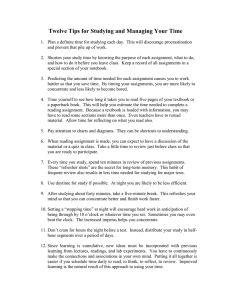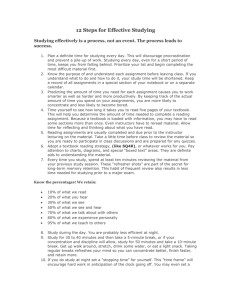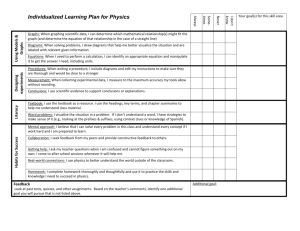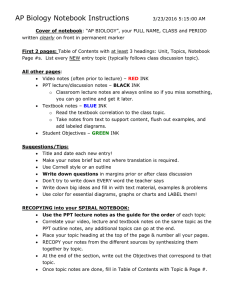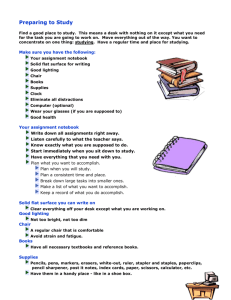The Top Ten List of Study Skills Needed to Succeed in Biology
advertisement
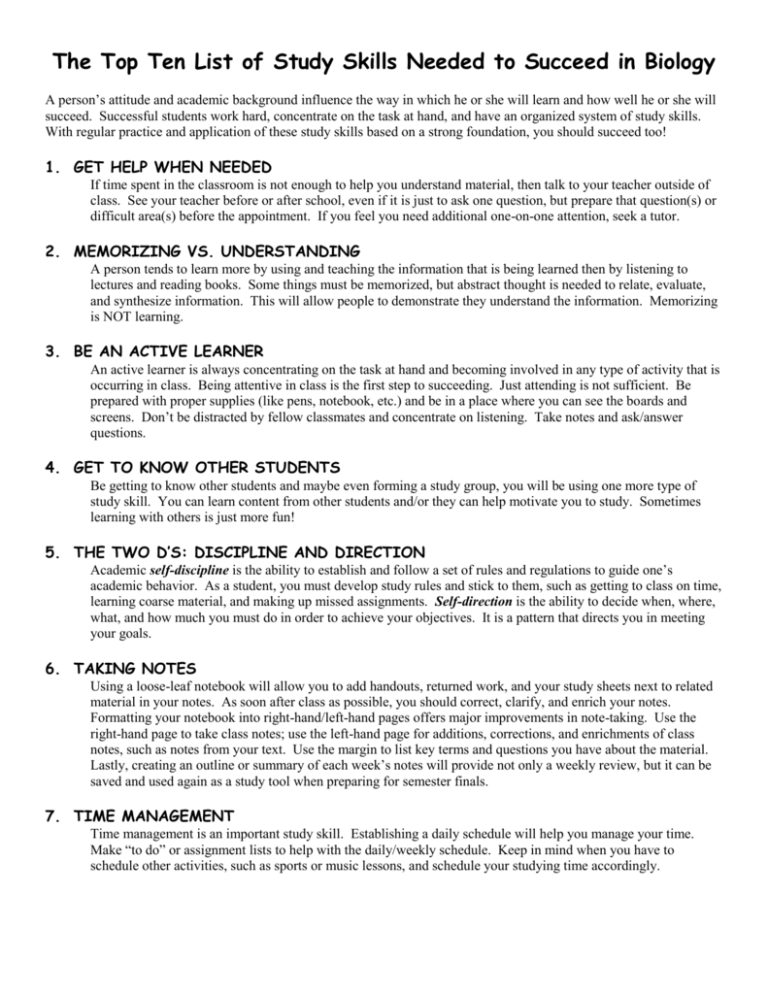
The Top Ten List of Study Skills Needed to Succeed in Biology A person’s attitude and academic background influence the way in which he or she will learn and how well he or she will succeed. Successful students work hard, concentrate on the task at hand, and have an organized system of study skills. With regular practice and application of these study skills based on a strong foundation, you should succeed too! 1. GET HELP WHEN NEEDED If time spent in the classroom is not enough to help you understand material, then talk to your teacher outside of class. See your teacher before or after school, even if it is just to ask one question, but prepare that question(s) or difficult area(s) before the appointment. If you feel you need additional one-on-one attention, seek a tutor. 2. MEMORIZING VS. UNDERSTANDING A person tends to learn more by using and teaching the information that is being learned then by listening to lectures and reading books. Some things must be memorized, but abstract thought is needed to relate, evaluate, and synthesize information. This will allow people to demonstrate they understand the information. Memorizing is NOT learning. 3. BE AN ACTIVE LEARNER An active learner is always concentrating on the task at hand and becoming involved in any type of activity that is occurring in class. Being attentive in class is the first step to succeeding. Just attending is not sufficient. Be prepared with proper supplies (like pens, notebook, etc.) and be in a place where you can see the boards and screens. Don’t be distracted by fellow classmates and concentrate on listening. Take notes and ask/answer questions. 4. GET TO KNOW OTHER STUDENTS Be getting to know other students and maybe even forming a study group, you will be using one more type of study skill. You can learn content from other students and/or they can help motivate you to study. Sometimes learning with others is just more fun! 5. THE TWO D’S: DISCIPLINE AND DIRECTION Academic self-discipline is the ability to establish and follow a set of rules and regulations to guide one’s academic behavior. As a student, you must develop study rules and stick to them, such as getting to class on time, learning coarse material, and making up missed assignments. Self-direction is the ability to decide when, where, what, and how much you must do in order to achieve your objectives. It is a pattern that directs you in meeting your goals. 6. TAKING NOTES Using a loose-leaf notebook will allow you to add handouts, returned work, and your study sheets next to related material in your notes. As soon after class as possible, you should correct, clarify, and enrich your notes. Formatting your notebook into right-hand/left-hand pages offers major improvements in note-taking. Use the right-hand page to take class notes; use the left-hand page for additions, corrections, and enrichments of class notes, such as notes from your text. Use the margin to list key terms and questions you have about the material. Lastly, creating an outline or summary of each week’s notes will provide not only a weekly review, but it can be saved and used again as a study tool when preparing for semester finals. 7. TIME MANAGEMENT Time management is an important study skill. Establishing a daily schedule will help you manage your time. Make “to do” or assignment lists to help with the daily/weekly schedule. Keep in mind when you have to schedule other activities, such as sports or music lessons, and schedule your studying time accordingly. 8. USE YOUR TEXTBOOK Your textbook will contain information and examples that will help to reinforce and supplement the class content. If information appears in lecture or lab notes and in your textbook, then that is the important information to learn. Read for understanding by following these helpful tips. A) Survey the reading selection by reading the introduction to the chapter, the list of objectives and just the headings and subheadings. Also look at the boldface terms, figures and summaries. Scan the questions or problems at the end of the chapter to help direct your reading. The survey should take only 10 – 15 minutes. B) After the survey, its time to read. You should read slowly and carefully for detail. You might want to underline or highlight certain phrases and star or mark certain concepts in the margins. Every once in a while, cross-reference the information you are reading with the information in your notes. Place some sort of identifying symbol in your notes that indicates where the information is in the textbook. Make sure to write down any questions you have about what you are reading to ask your teacher at a later time. C) Review what you have read by re-reading your highlights and looking at the diagrams again. D) Practice what you have learned by completing the questions at the end of the section or chapter, by drawing your own concept maps, outlines, or diagrams, or by trying to explain what you have read to another person like a classmate or parent. 9. WHAT TO STUDY? The most important things to study are those that the teacher discusses in class, especially if a lot of class time is spent on it and it is also covered in the textbook or if it is part of the homework assignment. So, combining class notes with notes from your readings is quite beneficial, including diagrams and pictures. When studying laboratory materials, it is important that you learn terminology; tool functions; units of measurement; symbols used; how to interpret graphs and test results; and how to carry out experiments and record results. Practice any type of homework problems assigned throughout the unit. 10. TESTS A) Preparing Concentrate on the information to be learned, and begin by reviewing difficult areas first. Find out as much about the test as possible beforehand, such as the format of the test and/or important areas that will be covered. Prepare by studying all of the material covered in #9, “What to Study?.” Then, test yourself with questions from the text or other sample test questions, or questions you have made yourself. Studying for a test should begin a week before the test. Cramming is never worth it! Finally, when going into a review session, whether it is with a study group or with your teacher, have questions prepared ahead of time by reviewing the material before the session. B) Taking Tests Read and follow instructions given by your teacher and make changes/corrections to the test before beginning it. Survey the entire test by identifying the number and format of the questions. Read questions carefully, looking for key words to help you recall information and note whether the choices include a combination of answers. When choosing an answer, eliminate nonsense choices or use clues from other questions to help you answer. Save more difficult questions for last and answer the easiest questions first. Review the test before handing it in, proofread the answers, and check to see if you have answered everything. When it comes to learning: “You can lead a horse to water but you can’t make him drink it.”
